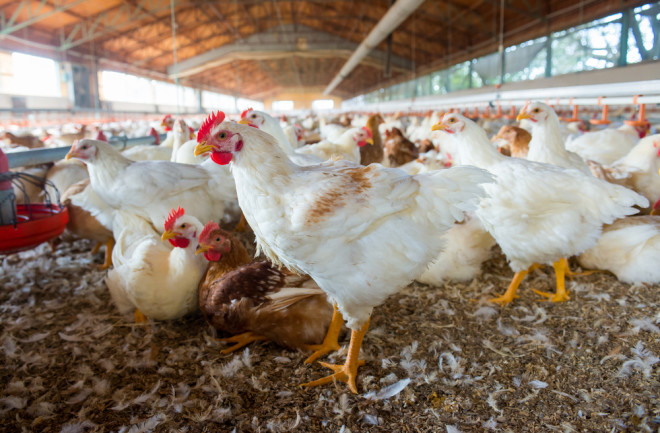The early days of a deadly virus that has run rampant in chicken populations for decades — Marek’s Disease Virus (MDV) — can now be explained thanks to DNA from 1,000-year-old chickens. A new study from an international team of researchers has determined how MDV has progressively worsened in chickens, causing a prolonged panic within the poultry industry.
In the study, published inthe journal Science, researchers from the University of Oxford and Ludwig Maximilian University of Munich compared MDV genome sequences from ancient chickens with sequences found in modern chickens. Through this comparison, they could identify the genetic alterations that have led to the elevated strength of the modern virus.
The success of this discovery, as reported in a press release, can be attributed to chicken bones that were excavated from 140 archaeological sites across Europe and the Near East. DNA from the bones confirmed that MDV existed far before it was first described in 1907 — the disease was widespread in European chickens at least 1,000 years before this point, catapulting its origin story back to ancient times. However, analysis of these genetic sequences came with the revelation that the old strains were not nearly as powerful as current strains.
How Has MDV Gotten Worse in the Past Decades?
When Hungarian veterinarian József Marek first reported the disease in 1907, only mild symptoms in older chickens were described. Later named after Marek, the disease experienced a dramatic spike in the 1950s and ‘60s. At this time, a burgeoning agricultural revolution introduced massive changes in farming; thousands of farms were closing while a few others were consolidating, and production skyrocketed to fit the needs of a growing population that began to consume more chicken.
Poultry farming took on a new form defined by vertical integration and mass production of broiler chickens, which were specifically bred for meat consumption. The establishment of intensive practices during this time caused Marek’s disease to flourish. The poultry industry still endures the aftermath decades later, as the disease causes a loss of $1 to 2 billion every year.
Professor Venugopal Nair, scientist emeritus at The Pirbright Institute in the U.K., noted the connection between poultry farming and MDV, saying that the study’s findings “will provide great scientific opportunities to explore the molecular mechanisms of increasing virulence of this virus that coincided with the intensification of poultry farming from the 1960s.”
Read More: How Scientists Are Creating the Crops of the Future
What Are the Symptoms of MDV?
Chickens become infected with Marek’s disease by inhaling feather dander and dust containing the airborne virus. MDV is usually associated with wing and leg paralysis; Other symptoms include enlargement of peripheral nerves, growth of tumors, immunosuppression, brain swelling, and rashes.
Since MDV is a highly contagious disease, transmission among chickens occurs quickly when an infected bird is introduced into a flock, and they carry the virus for long periods. According to the recent study, MDV infections kill more than 90 percent of unvaccinated birds.
Read More: Self-Spreading Animal Vaccines Could Combat Human Pandemics
How Does Vaccination Affect MDV Transmission?
Keeping MDV in check has been difficult over the years. Vaccination can reduce the pathogen load, but the MDV vaccine — considered an imperfect vaccine — cannot fully block the disease.
This type of vaccine, usually referred to as “leaky vaccine,” has become a primary point of concern in Marek's disease research. Leaky vaccines prevent symptoms of disease but do not eliminate the potential for infection and transmission. The MDV vaccine has reduced mortality in chicken populations, but researchers continue to debate its role in encouraging the evolution of progressively stronger MDV strains.
Some arguments point to the aforementioned benefits of the vaccine, while others maintain that MDV grows more virulent when it circulates within vaccinated chickens that will survive and then pass on the virus to unvaccinated chickens. Emerging strains may also break through the protection offered by vaccination.
Future studies of leaky vaccines will hold significant implications for disease transmission in livestock, and the potential relevance for humans has also been considered.
Read More: Zoonotic Diseases That Have Been Transferred to Humans
Answers From the Past
The origins of Marek’s disease, as the study in Science has observed, provide a crucial blueprint for understanding virus evolution. The link between ancient and modern chickens as carriers of disease, according to the authors, “highlights the importance of preserving archaeological remains, especially given their power to reveal valuable insights into the evolution of virulence.”
“Our findings not only unravel the evolutionary history of the Marek’s Disease Virus but also provide a foundation for enhancing our current understanding of pathogen virulence,” says first author and University of Oxford researcher Steven Fiddaman. “By combining ancient DNA techniques with modern genomics, we’ve opened a window into the past that can guide future strategies in managing viral diseases.”

